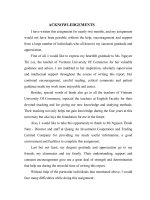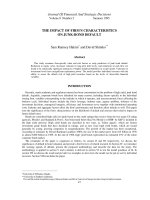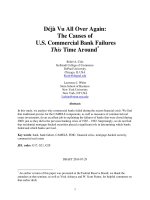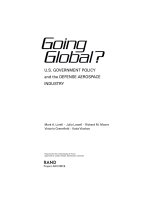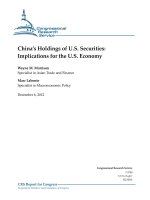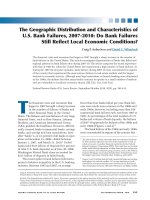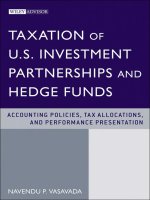Taxation of U.S. Investment Partnerships and Hedge Funds ppt
Bạn đang xem bản rút gọn của tài liệu. Xem và tải ngay bản đầy đủ của tài liệu tại đây (1.47 MB, 302 trang )
Taxation of U.S.
Investment Partnerships
and Hedge Funds
Taxation of U.S.
Investment Partnerships
and Hedge Funds
Accounting Policies,
Tax Allocations, and
Performance Presentation
NAVENDU P. VASAVADA
John Wiley & Sons, Inc.
Copyright © 2010 by John Wiley & Sons, Inc. All rights reserved.
Published by John Wiley & Sons, Inc., Hoboken, New Jersey.
Published simultaneously in Canada.
No part of this publication may be reproduced, stored in a retrieval system, or
transmitted in any form or by any means, electronic, mechanical, photocopying,
recording, scanning, or otherwise, except as permitted under Section 107 or 108 of
the 1976 United States Copyright Act, without either the prior written permission
of the Publisher, or authorization through payment of the appropriate per-copy fee
to the Copyright Clearance Center, Inc., 222 Rosewood Drive, Danvers, MA 01923,
978-750-8400, fax 978-646-8600, or on the Web at www.copyright.com. Requests to
the Publisher for permission should be addressed to the Permissions Department,
John Wiley & Sons, Inc., 111 River Street, Hoboken, NJ 07030, 201-748-6011,
fax 201-748-6008, or online at www.wiley.com/go/permissions.
Limit of Liability/Disclaimer of Warranty: While the publisher and author have used
their best efforts in preparing this book, they make no representations or warranties
with respect to the accuracy or completeness of the contents of this book and
specifi cally disclaim any implied warranties of merchantability or fi tness for a
particular purpose. No warranty may be created or extended by sales representatives
or written sales materials. The advice and strategies contained herein may not be
suitable for your situation. You should consult with a professional where appropriate.
Neither the publisher nor author shall be liable for any loss of profi t or any other
commercial damages, including but not limited to special, incidental, consequential,
or other damages.
For general information on our other products and services, or technical support,
please contact our Customer Care Department within the United States at
800-762-2974, outside the United States at 317-572-3993, or fax 317-572-4002.
Wiley also publishes its books in a variety of electronic formats. Some content that
appears in print may not be available in electronic books.
For more information about Wiley products, visit our Web site at http://www.
wiley.com.
ISBN 978-0-470-60575-2 (cloth); ISBN 978-0-470-64256-6 (ebk);
ISBN 978-0-470-64257-3 (ebk); ISBN 978-0-470-64258-0 (ebk)
Printed in the United States of America.
10 9 8 7 6 5 4 3 2 1
To Rupangi
with love and appreciation
vii
Contents
Preface xiii
CHAPTER 1 The Arcane World of Hedge Funds and Investment
Partnerships 1
What Is a “Hedge Fund”? 1
U.S. Venture Partnerships 3
Types of U.S. Hedge Fund Entities and the U.S.
Tax Code 4
Organizing a Typical U.S. Hedge Fund 6
Investor Clienteles in Hedge Funds 10
Foreign Investors in a U.S. Hedge Fund 14
Offshore Funds 14
U.S. Investors in Offshore Funds 17
U.S. Investors in Swiss Bank Accounts 19
U.S. Investors in Madoff-Like Managed
U.S. Trading Accounts 23
Size of the Global Hedge Fund Industry 25
Fund-of-Funds 28
Incentives of the Hedge Fund Manager
and Investors 30
Valuation of a Hedge Fund Management Company 31
Economies of Scale in Hedge Funds 33
CHAPTER 2 The Structure of Hedge Funds 35
Organizing a Typical Offshore Hedge Fund 35
Master-Feeder Structuring of Onshore/Offshore Arms:
Organizing a Hedge Fund for Clienteles 39
U.S. Withholding Agent for U.S. Withholding Taxes
on Foreign Investors 44
viii Contents
CHAPTER 3 Hedge Fund Fees 47
Starting Point: The Partnership Agreement 47
Fund Valuation at Discrete Opening Time Points 48
Calculation of Fixed Fees 49
Calculation of Performance Fees 55
Claw-Back Provision: Performance Fee Returned to
Limited Partners 66
Representation of a Fund’s Net Asset Value (NAV)
per Share 71
Black-Scholes Formula Valuation of Performance Fees 74
CHAPTER 4 Hedge Fund Accounting and Tax Filing 79
Partnership Accounting for U.S. Funds 79
IRS Tax Return Filings for U.S. Hedge Funds 80
Financial Statements for Hedge Funds and
Venture Funds 85
Interim Valuation: The Core of a Hedge Fund’s
Accounting Operation 93
Books of Account and Financial Statements for
Hedge Funds 96
Audit of an Offshore Fund 97
Audit of a U.S. Fund 98
Capital Account Audit for Both Offshore and
U.S. Funds 99
CHAPTER 5 Partner Tax Allocations in U.S. Partnerships 101
U.S. Tax Allocation Rules Governing
U.S. Partnerships 101
Tax Components of U.S. Investment
Partnership Income 103
Fixed Fees: Income to the General Partner and
Expense to the Limited Partners 107
Generalizing the Allocation Formula to Other
Components of Income 108
Tax Basis of Partner’s Investment in
a U.S. Partnership 109
Accountants’ Terminology 113
Tax Allocations of Realized and Unrealized Income
to Partners 113
The Tax Allocation Method of Layering 115
Tax Allocation of Interest 118
Contents ix
Tax-Exempt Interest Income, Line 18a 120
Similar Calculation for Tax Allocation of Dividends,
Investment Expense, Foreign Tax Paid 121
Tax Allocation of Fixed Fees Paid by Limited
Partners 121
Tax Allocation of Guaranteed Payments
(of Fixed Fees) to the General Partner 122
Reporting Subcomponents of Interest Income and
Dividends 122
Tax Consequences of Shorting 123
Short Positions: Tax Treatment of Equity Dividends
or Bond Coupons Claimed as Interest Expense 123
Distributions from Partnerships Owned 124
CHAPTER 6 Tax Allocations of Realized Gains by Layering 127
Tax Allocation of Unrealized and Realized Capital
Gains Using the Method of Layering 127
Ignoring Ambiguity #1 with Layering 132
Work-Around to Fix Ambiguity #2, the Fatal Flaw
with Layering 133
CHAPTER 7 Partial and Full Netting Methods 137
The Methods of Aggregation or Netting 137
Partial Netting 138
Full Netting 141
Measures of Book-Tax Disparity across Partners 142
Formulating the Problem for Optimal Partner Tax
Allocations under Full Netting 143
Formulating the Problem for Optimal Partner Tax
Allocations under Partial Netting 146
Solving the Convex Optimization Problem of
Tax Allocation 148
CHAPTER 8 Comparative Tax Consequences of Layering and
Netting Methods 153
Which Is the Better Method for Allocation of
Realized Gains: Layering, Full Netting, or
Partial Netting? 153
Layering Examples Showing Earlier Tax Payment 154
Full Netting Examples Showing Tax Postponement 158
x Contents
CHAPTER 9 Tax Effi ciency of Hedge Funds 161
Tax Effi ciency Considerations for Offshore
Hedge Funds 161
Tax Preference Ordering for U.S. Investors 163
More Attractive Tax Items to U.S. Investors 167
Less Attractive Tax Items to U.S. Investors 169
An Exception: Special Tax Preference for Gains
from U.S. Exchange-Traded Futures Contracts 170
Ambiguities in Tax Preference 170
Tax Effi ciency Steps for U.S. Hedge Funds 170
A Structure for Tax-Exempt U.S. Entities to Recover
Foreign Taxes 173
CHAPTER 10 Hedge Fund Performance and Risk Presentation 175
Performance Presentation: CFA Institute GIPS
Verifi cation 175
Calculation of Hedge Fund Returns for Performance
Presentation 179
Facilitating Historical Risk and Return Review for
Investors Using GIPS Guidelines 183
CHAPTER 11 Mutual Funds and Venture Funds Compared to
Hedge Funds 191
Tax Return Filing of U.S. Partnerships Is an
Involved Task 191
Comparison with Tax Allocations Made by
Mutual Funds 191
U.S. Venture Partnerships (Silicon Valley
Venture Funds) 196
CHAPTER 12 Epilogue 203
Economic Accounting Is a Common Denominator
for U.S. and Offshore Funds 203
Tax Return Filing of U.S. Partnerships Is an
Involved Task 204
Calculating Partner Allocations Is Most of a U.S.
Partnership’s Tax Accounting Effort 204
Layering and Netting Methodologies for Tax
Allocation of Capital Gains 205
Contents xi
Example of Tax Allocation of Capital Gains by Full
and Partial Netting in a 100-Partner Setting 205
Tilting Tax Allocations According to Tax Preferences 206
The Crown Jewel: Automated Tax Allocation of
All Items of Income 206
The End of an Era of Layering 207
APPENDIX 1 Excerpts of Key U.S. Statutes Discussed in Chapter 1
That Govern U.S. and Offshore Hedge Funds
Venture Funds 209
APPENDIX 2 Methodology and Implementation Example of
Full Netting 229
APPENDIX 3 Methodology and Implementation Example of
Partial Netting 253
APPENDIX 4 Nonabusive Tilting of Tax Allocations According
to Tax Preferences 259
APPENDIX 5 Eliminating Layering Entirely, by Allocating
Dividends, Interest, Capital Gains, and Expenses
in One Step 267
Index 277
xiii
Preface
O
ver the last decade, I co - founded two U.S. investment partnerships as
chief investment offi cer (CIO), undertaking direct responsibility for
delivery of superior returns to partners. Investment partnerships that mainly
trade in securities are loosely called hedge funds, or simply funds, irrespec-
tive of whether they actually hedge to reduce risks. While venture capital
funds, such as venture funds in Silicon Valley, are basically U.S. investment
partnerships, they are considered a distinct breed from hedge funds.
I embarked upon my hedge fund career believing that I would mostly
focus on investment management strategy and securities trading. I engaged
an accountant as a contractor to perform all the bookkeeping and take
care of accounting issues. Over the years, I found that my role as managing
partner required ongoing conversations with lawyers and accountants on
the matters of securities law, disclosure documents, compliance require-
ments, offshore paperwork, critical tax matters pertaining to the hedge
fund, making decisions on accounting policies, and implementing the
details of Global Investment Performance Standards.
Initially, these tasks seemed overwhelming. Here I was, a novice,
having to talk with expert lawyers and accountants. I had believed that
engaging the best lawyers and accountants would enable me to comfort-
ably delegate these relevant matters to professionals. Yet every discussion
and decision taken in consultation with these serious professionals would
eventually require me to make the critical decisions. During this process,
my repertoire of relevant facts about partnership agreements, tax fi lings
and compliance with tax laws, and accounting procedures and policies
expanded greatly.
Over the years, I synthesized these facts into a knowledge base
suffi cient to make me reasonably well versed, if not a minor expert, on
hedge fund structure, hedge fund accounting policies, and the taxation of
hedge funds and investment partnerships. I have written this book to docu-
ment my acquired knowledge and discoveries, without the pretense of
posing as a subject matter expert, with a view to improving the lives
of future generations of MBAs, CFAs, and hedge fund managers who
may otherwise have to struggle and take several years to grapple with
xiv Preface
the multifaceted word of hedge fund structure, accounting policies, and
taxation.
The fi rst several chapters of this book focus on hedge fund structure.
These are relevant at the time of forming the hedge fund and drawing up
the investment partnership agreement, as well as in making future amend-
ments as required to the original partnership agreement. The subsequent
chapters, which constitute the middle to end sections of this book, unravel
the nuances of accounting methodologies and policies for hedge funds.
Once the nature of hedge fund accounting is clarifi ed, the last part of this
book covers taxation of hedge funds. The last chapters describe strategies
as well as small matters of detail that would facilitate hedge funds in
improving their tax effi ciency. Whenever there is a complex and multifac-
eted taxation, the issue of optimal taxation and tax effi ciency arises. This
also applies to tax - exempt investors, who might search for mechanisms to
recover some part of foreign taxes directly paid by their hedge fund.
This book does not require the reader to be an accountant, a tax expert,
a tax lawyer, or a partnership contract lawyer. It is intended for the unwit-
ting MBA and CFA who leads a hedge fund but gets drawn into an arcane
world of legal, accounting, and tax matters, and despite delegation to
accountants and lawyers is ultimately responsible to tax and regulatory
authorities and to investors. Instead of presenting examples with hypotheti-
cal numbers, I mostly use the language of algebra. The book expects
familiarity with algebraic notation of basic economics and math to follow
the shorthand of algebra with subscripts and superscripts. Fortunately, the
world of fi nance MBAs, particularly those versed in quantitative fi nance,
comfortably deals with linear algebra, and for brevity we may sometimes
use shorthand notation with vectors and matrices, though one might run
into complex situations with nonlinearities that are mostly translations of
verbally stated offi cial rules and guidelines. Similarly, CFAs are intensely
examined for quantitative fi nance knowledge and are keenly aware of
solving for multiple unknowns. Accountants are usually comfortable with
numerical examples; we believe that the abstract representation in algebra
with only occasional use of numerical examples will not be daunting to
them, particularly when it relieves the anguish of accurately translating
loose, verbally stated regulations and procedures into distinct and unam-
biguous steps for hedge fund accounting and tax practice.
I am indebted to Jaime C. Dermody for providing spirited discussion
and inspiration, as well as extensive constructive comments.
N
AVENDU P. V ASAVADA
December 2009
Taxation of U.S.
Investment Partnerships
and Hedge Funds
1
CHAPTER
1
The Arcane World of
Hedge Funds and
Investment Partnerships
What Is a “ Hedge Fund ” ?
So, what is a hedge fund really? A “ hedge fund ” is an entity that offers
“ alternative ” investments to investors, distinct from “ traditional ” investments
in bonds and equities. A general counsel to the Securities and Exchange
Commission (SEC) aptly simplifi ed this as “ The term hedge fund is not
really descriptive, but just refers to a private pool of institutional capital. ”
1
One would have expected that in the freewheeling world of the Internet,
wiki volunteers would have arrived at a concise defi nition, in place of a
confusing opening attempt at defi nition: “ A hedge fund is an investment
fund open to a limited range of investors that is permitted by regulators to
undertake a wider range of investment and trading activities than other
investment funds, and that, in general, pays a performance fee to its invest-
ment manager. ”
2
In order to identify and decode the nature and character
of hedge funds and their secretive “ alternative ” investment or trading strate-
gies, we shall follow the U.S. SEC ’ s attempt to corral and codify this popular
object of perpetual regulatory concern.
1
“ The Future of Securities Regulation, ” Brian G. Cartwright, in a speech by SEC staff,
University of Pennsylvania Law School Institute for Law and Economics, October 24,
2007.
2
Wikipedia entry of “ hedge fund ” accessed on October 13, 2009, at ipedia
.org/wiki/Hedge_fund . Note that Wikipedia entries are dynamic.
2 Taxation of U.S. Investment Partnerships and Hedge Funds
In 2004, the U.S. SEC proposed hedge fund regulatory rules to bring
most hedge funds into its regulatory net. These were published in the U.S.
Federal Register in December 2004 and made effective February 2005, in
46 pages of fi ne print. The new rules lack both specifi city and brevity,
stating:
There is no statutory or regulatory defi nition of hedge fund, although
many have several characteristics in common. Hedge funds are orga-
nized by professional investment managers who frequently have a
signifi cant stake in the funds they manage and receive a management
fee that includes a substantial share of the performance of the fund.
Advisers organize and operate hedge funds in a manner that avoids
regulation as mutual funds under the Investment Company Act of 1940,
and they do not make public offerings of their securities. Hedge funds
were originally designed to invest in equity securities and use leverage
and short selling to “ hedge ” the portfolio ’ s exposure to movements of
the equity markets. Today, however, advisers to hedge funds utilize
a wide variety of investment strategies and techniques designed to
maximize the returns for investors in the hedge funds they sponsor.
Many are very active traders of securities.
The 2005 SEC rules remained in force for barely one year. In June
2006, the U.S. Federal Court of Appeals in the District of Columbia struck
down these 2005 SEC Hedge Fund regulatory rules.
4
During the remainder
of the administration of George W. Bush ’ s term through 2008, there was
no further attempt to pass new legislation to regulate hedge funds.
The Federal Court of Appeals ruling that reversed and cancelled the
SEC ’ s hedge fund regulation provides interesting counterperspectives in its
offi cial court opinion. The very fi rst line of the court opinion is “ Hedge
funds are notoriously diffi cult to defi ne. ” The court then provided an inter-
esting alternative defi nition by negation as “ Hedge funds may be defi ned
more precisely by reference to what they are not . ” In light of this federal
appeals court reversal, new rules of the type that the SEC sought to enact
under its own authority require higher legislative approval from U.S.
lawmakers.
3
The SEC rules entered into the Federal Register on December 10, 2004, are avail-
able to view in their entirety as a pdf fi le at the SEC Web page www.sec.gov/rules/
fi nal/ia - 2333.pdf .
4
The U.S. Court of Appeals for the District of Columbia has tabled it so opinion
for the viewing public is in the form of a pdf fi le at />docs/common/opinions/200606/04 - 1434a.pdf .
The Arcane World of Hedge Funds and Investment Partnerships 3
During the brief period when the new SEC rules were in force
(before they were struck down in court), many large hedge fund managers
registered with the SEC, even though they could have avoided such a
registration by remaining exclusively offshore entities. This was because
U.S. institutional investors indicated their preference to invest with hedge
fund managers who registered with the SEC. Thus, SEC compliance was
seen by U.S. institutional investors as a seal of good housekeeping, with
the advantage of recourse to the U.S. legal system should disputes arise.
Those hedge fund managers who operated as exclusively offshore entities
risked losing the signifi cant volume of their assets under management from
U.S. institutional investors desirous of pursuing alternative investments.
At the time the proposed SEC rules were being actively debated, many
neutral economists and policymakers warned that such SEC regulation of
hedge funds would likely drive hedge funds to offshore locations without
making any meaningful dent in their overall assets under management.
Indeed, large European banks and offshore fi nancial hubs might become
benefi ciaries of tightened U.S. regulation of hedge funds. The SEC regula-
tions imposed meaningful reporting and compliance burdens on hedge
fund managers that might have put small hedge fund managers at a cost
disadvantage relative to large hedge funds.
U.S. Venture Partnerships
Although hedge funds have obtained media limelight in the past two
decades, their plain older cousins, venture - capital partnerships, also orga-
nized as U.S. limited partnerships with almost the same exact structure as
hedge funds, including the structure of management and performance fees,
but they have received less media attention. Contrary to hedge funds,
typical Silicon Valley venture partnerships have been objects of admiration
for achieving multibillion - dollar companies in a reasonably short time based
on entrepreneurial seeds, mostly located in college dormitories and
neglected academic university laboratories, mostly in their local geography
vicinity, with Stanford University serving as an anchor showcase. The cre-
ation of Genentech out of a single molecular biology researcher ’ s lab at
the University of California at San Francisco based on an investment of less
than $100,000 by Kleiner, Perkins, Caufi eld & Byers (Kleiner Perkins), and
the more recent rapid growth of Google out of a personal project of
Stanford University graduate students, also associated with early investment
by Kleiner Perkins, would remain showcases.
Chapter 11 elaborates upon to the nuances and differences between
hedge funds and venture funds, as well as primary aspects of pass - through
taxation to taxable U.S. Investors, and concerns regarding Unrelated
4 Taxation of U.S. Investment Partnerships and Hedge Funds
Business Tax on Income (UBTI) for tax - exempt U.S. investors. Until then,
much of the subsequent discussion on hedge funds almost exactly applies
to U.S. Venture Funds (or, more appropriately, Silicon Valley venture
funds).
We have not separately reviewed U.S. oil and gas partnerships, which
were extremely popular in the 1980s. Their popularity was largely fueled
by then - prevailing tax credits and deductions from intangible drilling costs
and accelerated depreciation. Many investors believed that the tax benefi ts
outweighed their investment cost, even if oil and gas were never found.
Types of U.S. Hedge Fund Entities
and the U.S. Tax Code
At origination, a U.S. investment fund makes a primeval choice by type-
casting itself into one of the various molds of U.S. federal taxation: It is
obliged to seek a U.S. taxpayer ID number as a subchapter C corporation,
a subchapter S corporation, a SEC - regulated investment company, or part-
nership, following the creation of such an entity in a corporate entity -
friendly state such as Delaware. Its physical place of business would most
likely be a hedge - fund - friendly state, in terms of state securities laws, such
as Connecticut.
A subchapter S entity is almost never chosen to structure an investment
fund due to the limited number of investors that it can have (at most 100).
Its investors/shareholders should be natural persons who are citizens or
residents of the United States, which precludes the inclusion of institutional
investors and foreigners. Similarly, a subchapter C entity is almost imme-
diately banished from consideration due to its fl at 35 percent U.S. corporate
tax on all future profi ts (with the exception for reduced taxation on U.S.
source dividends, called the “ dividends reduced deduction ” ).
Further, dividends and distributions to shareholders from such a sub-
chapter C entity are double taxed (i.e., taxed once again) in the hands of
the shareholders when remitted. The Bush administration softened the blow
of double taxation by taxing dividends on holdings of more than 60 days
at a reduced tax rate of 15 percent in the hands of the shareholders, under
new rules that defi ne such “ qualifi ed dividends. ” It is rare but not unusual
to fi nd a maverick fund manager operating what is largely an investment
fund in the form of a subchapter C corporation. For instance, Warren
Buffett ’ s Berkshire Hathaway Corporation is only nominally an industrial
company and is considered by many investors to be a grand mutual fund.
Its subchapter C standing attracts double taxation. It remains a puzzle that
this brilliantly managed pseudo industrial de facto fi nancial and portfolio
investment entity stands out alone as a subchapter C corporation, when
The Arcane World of Hedge Funds and Investment Partnerships 5
every other fund manager is seeking to typecast their entity under the
lowest possible tax regime with the lightest regime of regulation.
The SEC regulated investment company, more commonly called a
mutual fund,
5
is also a tax pass - through entity. There is no U.S. corporate
or state tax at entity level that applies to such a company. However, the
constraints of operating a regulated mutual fund under the U.S. Investment
Company Act limit the range of feasible and permissible investment
strategies. The world of venture capital funds, private equity funds, illiquid -
securities funds, and hedge funds is disjoint from the world of SEC -
regulated mutual funds. The latter is organized mainly for the benefi t of
small investors.
The overwhelming majority of U.S. venture capital funds, private equity
funds, illiquid securities funds, and hedge funds are formed as pass - through
partnerships under the U.S. tax code. Most lawyers would use the expres-
sion “ investment partnership ” as formal representation for a hedge fund as
well as its close cousin of Silicon Valley, a venture fund. The latter have
become more colloquial terms.
The source income from U.S. investment partnerships is not subjected
to paying two layers of tax, as is the case with a U.S. subchapter C entity,
by organizing themselves as pass - through partnership entities for the
purpose of taxation under U.S. tax law. A U.S. limited partnership or a U.S.
limited liability company is permitted to fi le its tax returns as a partnership,
paying no direct corporate tax as would a subchapter C corporation,
passing through its taxable income to its partners, who in turn are taxed
as individuals. Thus, the income and earnings of the hedge fund or invest-
ment partnership are taxed only once, at the relevant marginal tax rate of
each partner. Tax - exempt U.S. partners would not be paying any tax.
However, the investment partnership must avoid being classifi ed as a U.S.
“ publicly traded partnership. ”
6
If such classifi cation were to occur, the
partnership would be treated as if it were a subchapter C corporation for
federal tax purposes, and would have to pay corporate tax. Further, invest-
ment partners who receive cash fl ows that are considered to be dividends
would be taxed once again on such cash fl ows. Nearly all U.S. invest-
ment partnerships, both hedge funds and venture funds, qualify not to be
deemed publicly traded partnership due to not having an active secondary
5
A mutual fund is a regulated investment company that is governed by the Investment
Company Act of 1940, described in 15 U.S.C. Sections 80a - 1 to 80a - 64, available at
www.law.cornell.edu/uscode/html/uscode15/usc_sup_01_15_10_2D_20_I.html .
6
Section 7704 of the Internal Revenue Code defi nes a publicly traded partnership
and provides exceptions to the defi nition: a partnership with 90 percent or more
of its gross income consists of dividends, interest, rents, and capital gains, and its
interests should not be readily tradable in a secondary market.
6 Taxation of U.S. Investment Partnerships and Hedge Funds
market in its partnership interests, and due to producing nearly all of its
income comes from “ qualifying ” sources, that is, dividends, interest, rents,
and capital gains.
Hedge funds that pursue computerized high - frequency trading strate-
gies and decide to count the trading profi ts as operating income, as opposed
to capital gains, would be trading partnerships. This is not a preferred
form of structuring, except for trading partnerships that incur signifi cant
expenses and desire to offset these expenses directly with trading income.
Organizing a Typical U.S. Hedge Fund
The hedge fund manager, formally the general partner to the hedge
fund, a U.S. limited partnership (LP), is typically a U.S. limited liability
company (LLC), which for U.S. tax purposes may elect to be taxed as a
partnership. The most popular U.S. state for formation of the hedge fund
general partner LLC and LP pass - through partnership entities is Delaware.
This is primarily because the relatively small state of Delaware has posi-
tioned itself among the 50 states as a friendly regime for corporate domicile,
with well - developed corporate laws and longstanding corporate case his-
tory in the state court system.
Delaware itself is a taxable state and imposes corporate tax on Delaware
entities having a physical business presence in the state. For this reason,
nearly all U.S. general partner entities establish a principal place of business
in a U.S. state other than Delaware, which does not impose corporate
taxes on LLC entities that are pass - through partnerships for U.S. federal tax
purposes. Connecticut is one such popular state for Delaware entities
setting up their principal place of business for hedge fund management
and operations. Thus, such a general partner LLC pass - through entity does
not pay either federal or state corporate tax on its income. All of the general
partner entity ’ s items of income are taxed only once, when passed through
to its partners.
The hedge fund manager, that is, the general partner, charges fund
management fees to its limited partners. The details of such fees, contractual
provisions, as well as tax consequences both to the limited partners and
the general partner are described later. The general partner is responsible
for the day - to - day operations, administration, and overall management of
the fund, and incurs management expenses.
Thus, a typical U.S. hedge fund structure is a pair . The hedge fund
sponsor organizer sets up two entities, usually in the state of Delaware.
The fi rst is typically a Delaware LLC (limited liability company) that becomes
the general partner of the second entity, a Delaware LP (limited partner-
ship). The general partner entity is governed by a private operating agree-
The Arcane World of Hedge Funds and Investment Partnerships 7
ment of the LLC signed by its members, who are its partners. LLC members
are granted limited liability by the State of Delaware. At a minimum, the
LLC agreement establishes the voting powers of members, designation of
a manager (who could be a member), power of attorney and authority
delegated to the manager, and profi t sharing among members. The limited
partnership entity is governed by its agreement of partnership. Delaware
and other states do not require the operating agreement of the LLC or the
partnership agreement of the LP to be fi led, so they remain private docu-
ments in private domain. For a limited partnership, Delaware requires a
sparse one - page formation document, “ Certifi cate of Limited Partnership, ”
provided on its Web site signed by an authorized representative of its
general partner LLC entity, such as its manager or member. Similarly,
the general partner entity, the LLC, fi les a sparse one - page formation
document provided on the Delaware state Web site, “ Limited Liability
Company Certifi cate of Formation, ” signed by an authorized person who
is either a member or simply an appointed or employed manager.
The GP/LP pair immediately obtain taxpayer identifi cation numbers
from the Internal Revenue Service (IRS) by fi ling the appropriate IRS Form
SS - 4, which requires clear identifi cation of the type of entity in a check
box. The LLC can elect to be either a subchapter C corporation or a part-
nership for the purposes of U.S. taxation. The LLC entity (which is general
partner to the LP) wisely elects to be taxed as a pass - through U.S. partner-
ship to avoid double taxation that a U.S. subchapter C corporation would
face. The pair of entities is required to have nominal registered offi ces in
the state of Delaware, which is really the physical address of its Delaware -
registered agent named on the certifi cate of formation. The pair of entities
appoints such a state agent prior to seeking entity formation, for which the
agent charges a modest annual fee. The state of Delaware charges a modest
initial fi ling fee, which at this time is $200 for an LP and $90 for an LLC.
Subsequently, the LP and LLC that are formed in the State of Delaware are
not required to fi le an annual report but are required to pay an annual fl at
tax of $250.
The pair subsequently establish a common physical place of business,
which is typically in the state of Connecticut for hedge funds. For Silicon
Valley venture partnerships, the physical place of business is in the state
of California. (Silicon Valley venture partnerships have no particular affi nity
for Delaware and might elect to form their LP and LLC pair in Nevada or
California.) They are required to make Delaware - like fi lings in their state
of domicile and business presence, as a “ foreign ” out - of - state entity that is
doing business in the state.
Delaware courts have well - established precedents that fi rmly protect
the limited liability of partners in a limited partnership, as well as members
in a limited liability company. The managers and members of the Delaware

